Excerpts from Jim Conrad's
Naturalist Newsletter
entry dated August 16, 2022, issued from near Tequisquiapan, elevation about 1,900m (6200 ft), N20.565°, W99.890°, Querétaro state, MÉXICO
MORNING-GLORY BUSH
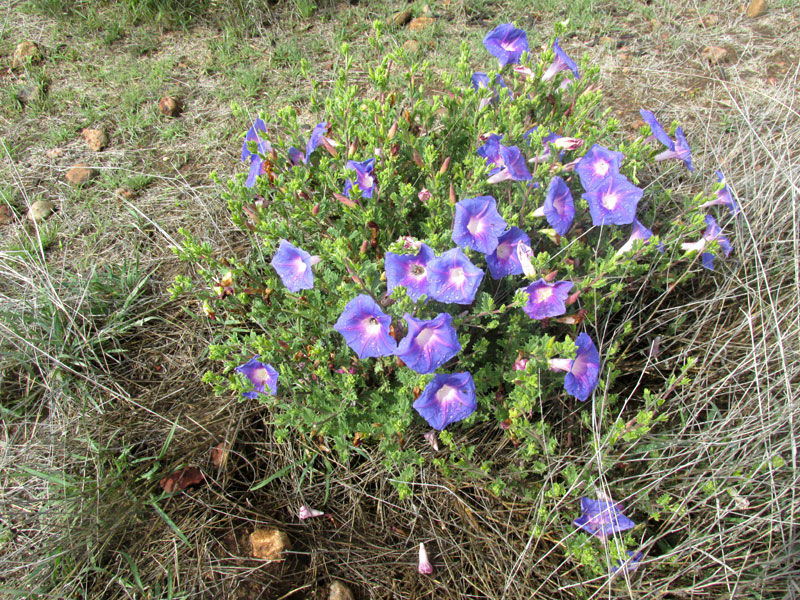
Maybe the above explosion of flowers results from the rainy season finally arriving, three months late. I'd been walking past this knee-high bush for nearly a year without noticing its difference from all the other knee-high bushes dotting the big abandoned, grossly overgrazed, rocky, fast-eroding field, so on this morning after an overnight rain this sudden blossoming was astonishing.
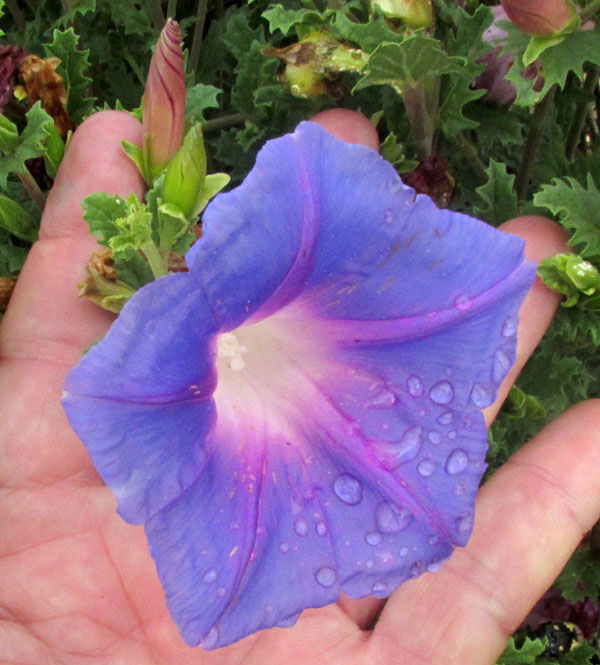
Even more surprising was that the big blossoms, which obviously were morning-glory flowers, arose from a bush in which no morning-glory vines or typical morning-glory leaves were apparent. In fact, in the above picture, the small, toothed leaves are those of the bush producing the flowers. On the upper, left side of blossom, you can see a green, tear-shaped, morning-glory flower bud arising from the bush's un-viny stem with leaves more like holly leaves than typical morning-glory flowers.
However, we've encountered woody Tree Morning-glories, so bush morning-glories must be allowed, too. But, who was this gorgeous bush? Remembering that just in our Bajío region of upland, semiarid central Mexico we have about ten genera of the Morning-glory Family, and that some of those genera are rich in species, certain details must be noticed:
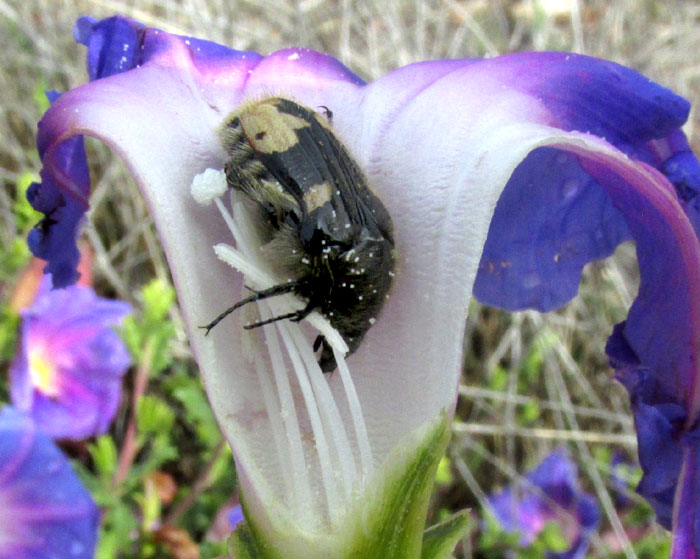
The surprises weren't over: The flower randomly chosen to break open to reveal the stamens, style and stigma -- with features important for morning-glory identification -- also revealed a beetle. Later it was identified by volunteer master-bug-identifier Bea in Ontario as a Bumblebee Flower Beetle, Euphoria basalis. In fact, over half the blossoms had inside them the same beetle species, all the insects alive but unmoving. Did they spend the rainy night sheltering inside the blossoms? Whatever the case with the beetles, the flower displayed a single style with a spherical stigma, and anthers that were straight, not twisty, unless being twisted by a beetle. Those features alone reduced the ten genera possible in our region down to two, so they're important features to note.
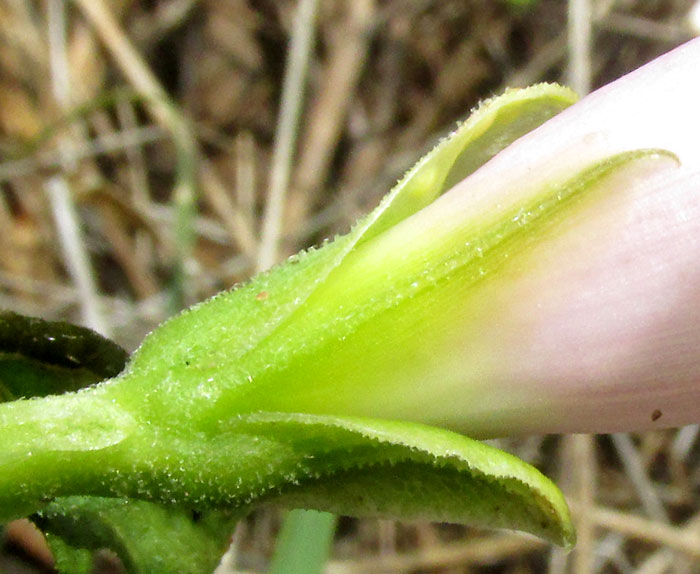
The flower's calyx was divided into five overlapping sepals of unequal size, and were sparsely hairy, which was normal for many morning-glory species. However, a mature, split-open, capsule-type fruit displayed more diagnostic features:
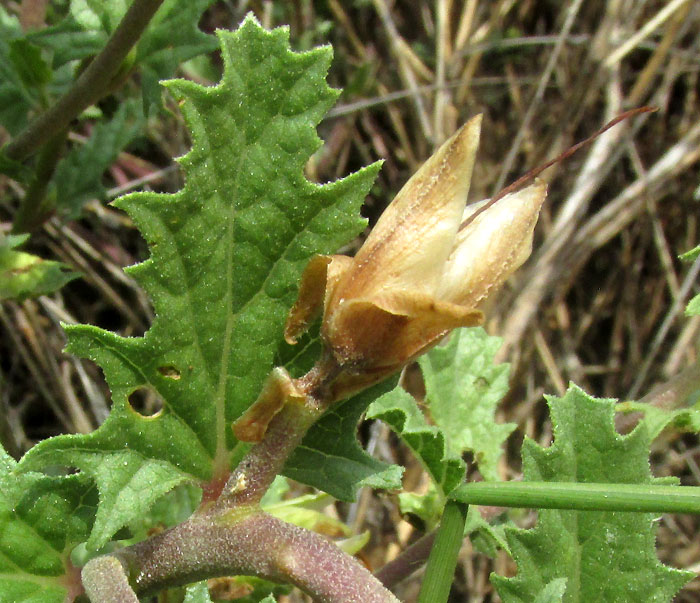
The capsule was split into two or four parts. Capsules of many species divide into odd-numbered parts. Finally, a look at the shrub's stems:
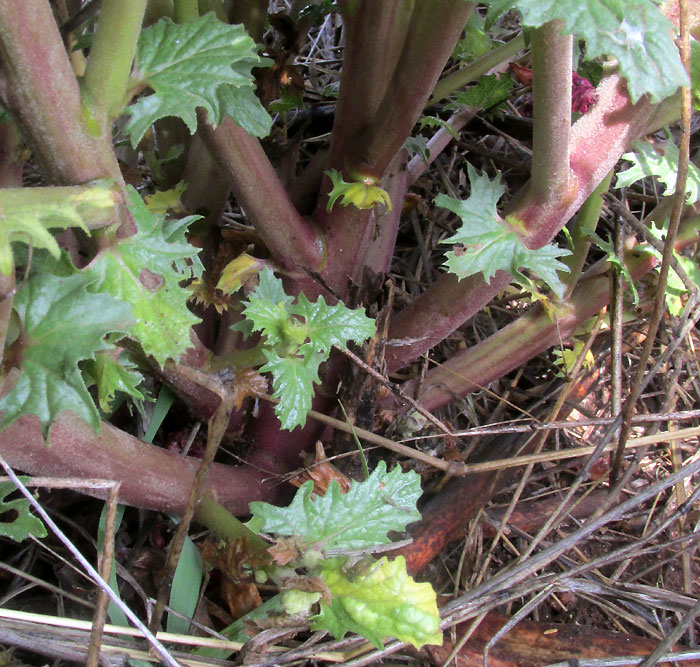
The stems were tough, but not woody. The technical term for such semi-woodiness is suffrutescent -- somewhat woody but not dying back each year.
Of the two genera sometimes producing flowers with one style bearing a spherical stigma, and anthers that aren't twisted, one, (Turbina), produces fruits that don't split open to release seeds, but the other does. The above mature fruit definitely has split open. That takes us directly to the genus Ipomoea.
Ipomoea, represented by 50 species just in our Bajío region, and is by far the largest genus in the entire Morning Glory Family. Ipomoea species can be a challenge to distinguish. However, in our area if you have an Ipomoea that's a non-woody shrub like ours, its large corolla is funnel-shaped and blue, the fruit opens like the above one with an even-number of compartments bearing seeds, and the sparsely hairy leaves are not divided into segments, it's IPOMOEA STANS.
Ipomoea stans -- in Latin stans means "standing erect" -- is endemic just to the dry uplands of west-central Mexico, from Coahuila state south to Oaxaca. It occurs mostly in pastures and abandoned fields at elevations of 1350-2750m (4400-9000 ft). In English it has no established name but at least the DavesGarden.Com website calls it Morning Glory Bush. In Spanish it goes by quite a few interesting ones such as campanita (Little Bell), espanta lobos (Wolf Frightener), espanta vaqueros (Cowboy Frightener), tumbavaqueros (Cowboy Tripper), limpia tunas (Cactus-fruit Cleaner), and others.
Surprisingly, the DavesGarden.Com website offers the only page I can find profiling our Morning-glory Bush as a garden ornamental. I'd thought that such a spectacular plant would be a garden favorite worldwide, and I can't explain why it isn't.
The online Atlas de las Plantas de la Medicina Tradicional Mexicana, which calls it galuza, mentions its roots being especially used as a purgative and for epilepsy. The roots are still sold in traditional markets, under the name of tumbavaqueros. For nervous conditions, one way to prepare the roots is to place them in alcohol for eight days and then spread the results on the back of the neck. For birth control, every month during menstruation the roots should be cooked and "taken." Numerous other uses are mentioned as well.
The 2007 study by Maribel Herrera-Ruiz and others entitled "Central nervous system depressant activity of an ethyl acetate extract from Ipomoea stans" concluded that ethyl acetate extract from the root of Ipomoea stans possesses "... anxiolytic and anticonvulsant effects, and could have potential sedative effect, probably through a GABAergic system. The extract did not show antidepressant effects on mice exposed to forced swimming test."